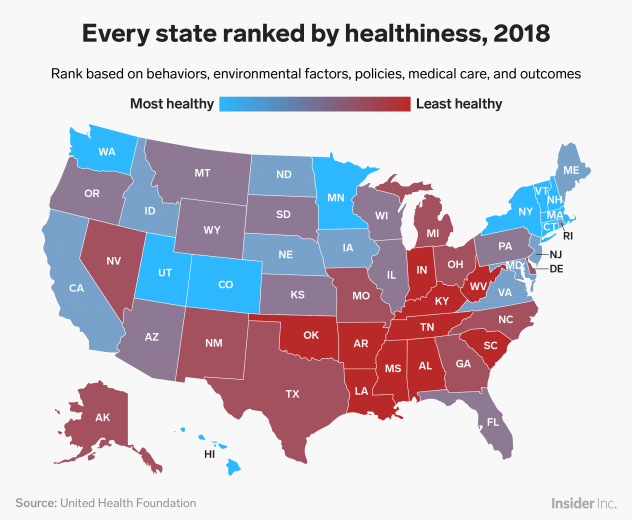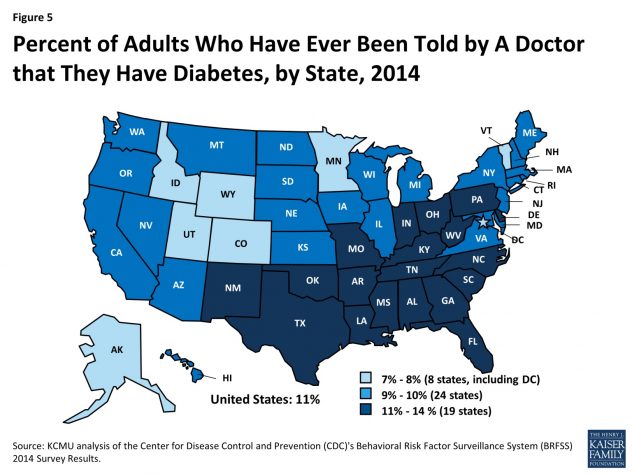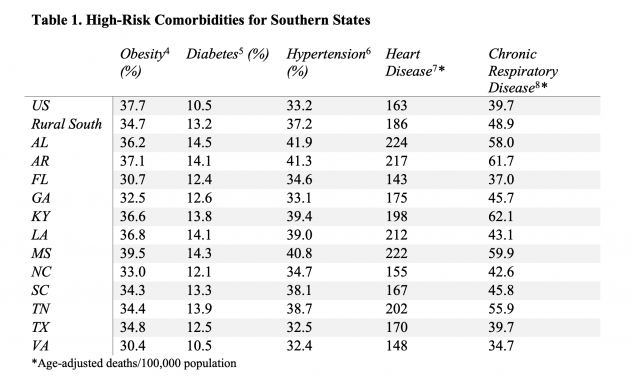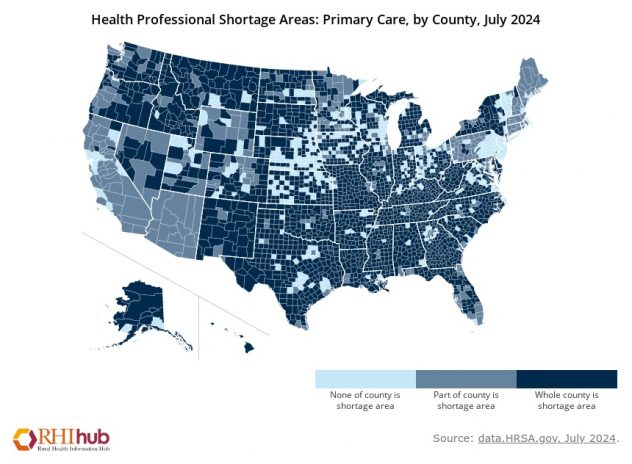
Writer: Saniya Pendharkar | Editor: Kiet Hoa
Introduction
Someone living in Mississippi is 85% more likely to die from cardiovascular disease than someone in Minnesota. If you’re a resident of Kentucky, you’re 55% more likely to die of cancer than someone in Utah on average. Unfortunately, if you’re living in West Virginia, you’re more than twice as likely to be diagnosed with diabetes compared to someone from Colorado. These stats come from America’s Health Ranking 2017 Report, which determines that the average life expectancy for someone living in a Southern state is about 74 years old; this is almost 10 years less than in the West, Midwest, and Northeast! The surprising truth is that people in Southern states are dying earlier on average, from chronic conditions, than people in other regions.
Almost all Southern states with poor health outcomes lie beneath the Mason-Dixon line, which served as a boundary between the Northern and Southern states during the American Civil War (1861-1865). Below is a map of the American Confederacy during the Civil War.

Figure 1: Map of the Southern (Grey) & Northern (Other colors) States in the US Civil War by National Geographic.
Now, below is a map of the United States’ healthiness in 2018.

Figure 2: Color-coded US map indicating the level of healthiness by Business Insider.
There’s an obvious overlap between the states that fought to preserve slavery in the 19th century and the ones that are still experiencing some of the worst health outcomes today. These states have higher rates of chronic illnesses, greater adult diabetes diagnoses, larger health professional shortages, and a lower life expectancy at age 40.
But, this can’t just be a crazy coincidence—there’s got to be something connecting all these states.
But what exactly is that connection? Could it be that the legacy of the Confederacy is still shaping the health of these states long after the Civil War ended? From economic systems to social structures, the echoes of the past might just be reverberating through today’s public health crisis. It’s not like health magically diverged after the US Civil War; health disparities were extremely prevalent between the North and South during this time, but why has nothing seemed to change over 150 years later?
A Screenshot of the South
According to the US Census, seventeen states plus Washington D.C. comprise the US South. As of 2024, this region had just over 130 million individuals, home to over one-third of the country’s population. Furthermore, a KFF issue brief reports that the South is racially and ethnically diverse, with people of color making up 42% of the population in 2014 compared to the 36% in the remaining US. Moreover, black residents make up almost double the share of the Southern population that other regions in the US (19% vs 8%). However, similar to the early United States, those in the South are more likely to be poorer. In fact, in 2014, 17% of the population lived below the Poverty Line, the highest percentage amongst all four regions.
But, is health in the South that much worse than in other regions? The short answer—Absolutely.
In 2014, 20% of adults in the South reported fair or poor health status. This was significantly higher than the percentages in the other regions. On average, Southerners are more likely to have chronic conditions such as diabetes and obesity. Additionally, among all regions, the South has the highest infant mortality rate and higher cancer death rates than the Northeast and West in 2014 (the Midwest had the highest cancer death rates).

Figure 3: Diabetes Diagnois in Adults, 2014. by KFF.

Figure 4: High-Risk Comorbidities for Southern States by Study the South.
The South also leads in the likelihood of being uninsured, according to a KFF report. Fifteen percent of total non-elderly people in the South are uninsured compared to 10% in the rest of the country. There are many reasons for this, as health insurance is a complicated issue; however, one cause could be that Medicaid and CHIP (Children’s Health Insurance Program) have more limited eligibility levels in the South. As of February 2025, ten states have not adopted ACA Medicaid expansion; seven of these states are in the South. In these states, the eligibility levels for parents are low, and adults without dependent children are eligible regardless of income. Compared to the other Southern states that have expanded Medicaid, the seven that haven’t have higher uninsured rates as of 2014.
Alright, so we’ve laid the groundwork. The South does have veritably worse health outcomes than other regions on average. Why is the South unhealthier, and can these reasons be traced back to the days of the Confederacy?
What’s Behind the Health Gap?
From poor healthcare access, to rurality, to racism, multiple key factors contribute to the South’s poor health outcomes. As mentioned above, Southern adults are less likely to be insured and covered. KFF also describes that adults in the South have a much harder time obtaining health services and prescription drugs. According to the South Florida Reporter, the reason is that the “majority of Southern workers [have] low-paying jobs” such as those in very small firms that lack health insurance benefits.
There is also an outstanding issue with claim denials in the Southern states. In a KFF article, it is reported that most states in the South have claim denial rates between 20% and 30%. These claim denial rates are among the highest in the country, creating significant barriers to healthcare access for millions of Southerners. This problem disproportionately affects racial and economic minorities, who are already more likely to face health disparities. The high rates of claim denials often result from limited insurance coverage, administrative hurdles, and stricter eligibility criteria in Southern states. As a result, many individuals are left without necessary care, further exacerbating the health inequalities that persist across the region.

Figure 5: Health Professional Shortage Areas (2019) by Niskanen Center.
Access to healthcare is only part of the issue; availability is another crucial factor. Georgia, Mississippi, Arkansas, and Alabama had some of the lowest numbers of primary care physicians per capita in 2018. This can largely be attributed to the fact that rural areas have a lower doctor-to-patient ratio than urban areas, and the South has more rural cities than other regions. According to Concordia University, Texas, the national urban ratio of doctors is roughly 1 for every 1485 people, and the rural ratio is 1 for every 1961 people. Rural hospitals also face greater risks of closure due to financial instability, lower patient volumes, and limited access to resources, further exacerbating the healthcare gap in these areas.
Lifestyles also vary between the South and other regions. The image of cowboys wrangling cattle on horseback may be iconic, but it has unfortunately become more of a stereotype than a true reflection of life on the Southern plains. According to a report by Consumer Project, the top ten states with the greatest percentage of adults engaging in little to no physical exercise are all Southern states. Furthermore, nine Southern cities occupied the top ten spots of the least walkable cities in the US in an analysis done by WalkScore. Narrow or absent sidewalks and scarce public transportation in the South, mixed with the ubiquity of massive public parking lots, results in people opting for car travel to traverse short distances. For me, a cool air-conditioned car beats walking a few blocks in the unforgiving Southern summer sun; however, a sedentary lifestyle has major health consequences. According to MedicalNewsToday, a sedentary lifestyle can increase the likelihood of chronic conditions like obesity, type 2 diabetes, some cancers, and heart disease.
The higher poverty rates experienced amongst Southerners contribute to unhealthy eating habits, which makes a damaging combination with sedentary lifestyles. Lower-income households are known to have higher calorie diets and to lack fruits and vegetables since they tend to be more expensive, and lower-income neighborhoods tend to have more convenience stores than grocery stores.
Finally, the higher poverty rates, long work hours, and overall poor health lead to higher stress levels in the South, creating a positive feedback loop that goes on to aggravate chronic conditions and mental health issues.
Has it always been like this? Let’s go back in time…
Health disparities between the South and other regions of the United States are not a recent phenomenon. During the Civil War, the Southern Confederacy experienced significantly worse health outcomes compared to the Northern Union. The Union had better access to medical resources, including a larger number of physicians and surgeons, along with a more organized and efficient medical system. In contrast, the Confederacy struggled with limited medical resources and a lack of infrastructure, which was further exacerbated by Union blockades that prevented essential medical supplies from reaching the South. As a result, soldiers and civilians alike suffered from poor medical care, higher rates of disease, and more frequent deaths.
The Civil War’s aftermath left the South in economic and health-related devastation. The region’s inability to industrialize was a key factor in its continued health struggles. The war drained the South’s capital, leaving it with little to invest in rebuilding its infrastructure, including hospitals and healthcare systems. The absence of industrialization meant fewer resources for innovation in public health, medicine, and sanitation. This stagnation in healthcare development widened the gap between the South and the more industrialized North, where technological advancements and improved healthcare systems helped foster better public health outcomes.
The economic disparities between the North and South that emerged after the war also had lasting effects on health. While the Union’s economy boomed due to increased production in the textile and iron industries, the South was left in ruin. Its agricultural economy, built on slavery, collapsed, and the destruction of infrastructure and the loss of slave labor further hindered economic recovery. The high death toll from the war, especially among white men, disrupted the social and economic fabric of the South. This economic devastation left the South in a state of prolonged poverty, which in turn contributed to poor health outcomes. The region’s inability to recover from these setbacks meant that the South was, and continues to be, more vulnerable to health crises, with fewer resources to address public health needs.
The Connections Between the Confederacy and Modern-day Health Outcomes are Clear
Is there a link between the poor health experienced by the Confederacy and the poor health experienced by the modern-day South? To Richard Steckel, there certainly is. Richard Steckel, an economist at Ohio State University, argues in his paper that the generations of poverty in the South caused by the Civil War “shaped people’s organs and physiology in a way that left them particularly unsuited for a cushy life”. Furthermore, he claims that the modern-day health discrepancies between the South and other regions are because Southerners eventually experienced a more prosperous life than their bodies had adapted to— things like more food and less manual labor. Stecke found that in states that “experienced a rapid rise out of poverty”, deaths from modern-day heart diseases were higher.
However, while Steckel’s argument sheds light on the historical roots of health disparities in the South, it is essential to consider another critical factor that has continued to exacerbate these inequalities: racial discrimination. The legacy of the Civil War, entrenched poverty, and unequal access to resources didn’t affect all Southerners equally—black communities, in particular, have faced ongoing barriers that have compounded their health challenges. Today, these systemic inequities are still evident, as racial disparities in healthcare access, treatment, and outcomes persist, contributing to poorer health outcomes among black people.
Conclusion
The health disparities in the South today are undeniably linked to the lasting impact of the Civil War and the Confederacy. The economic devastation and social upheaval that followed the South’s defeat created a cycle of poverty and poor health that continues to affect the region. The collapse of the Southern economy, compounded by the loss of slave labor and the destruction of infrastructure, left the South in a state of prolonged economic distress. This economic ruin created the foundation for the chronic health issues in the region today. While modern factors like sedentary lifestyles and poor diet certainly contribute, the roots of these disparities can be traced back to the Confederacy’s defeat and the economic and social instability that followed.
Furthermore, the legacy of racism and institutionalized inequality that emerged after the Civil War continues to exacerbate health disparities, particularly for Black communities in the South. The systemic barriers to healthcare access, along with higher rates of poverty and discrimination, have compounded the health challenges faced by people of color in the region. The historical inequities that were born out of the Confederacy’s loss and the failures of Reconstruction still echo through today’s public health crisis. To address these ongoing disparities, it is essential to recognize and confront the historical forces that have shaped the South’s health outcomes. Only by understanding and addressing the deep-seated legacy of the Confederacy can we begin to create an equitable healthcare system that provides better health outcomes for all Southerners.
Featured Image by Yiquan Zhang on Unsplash



